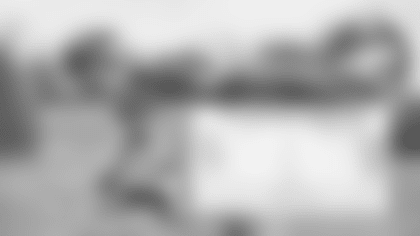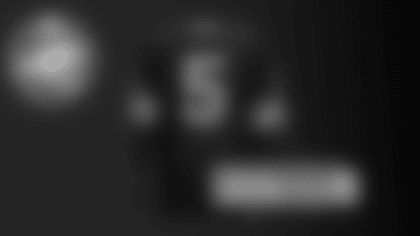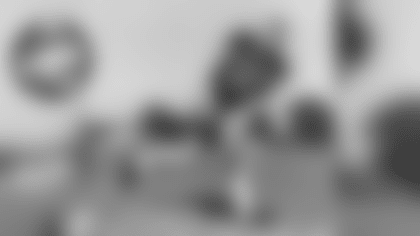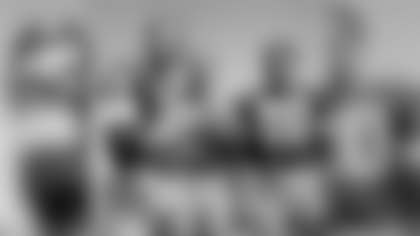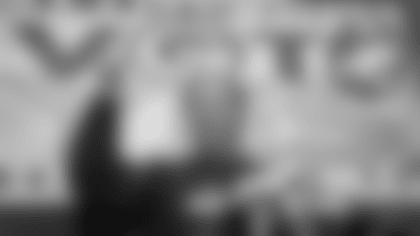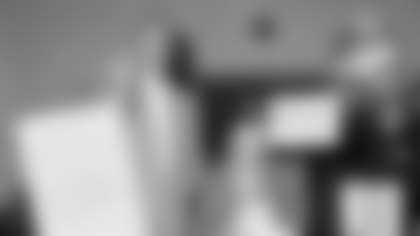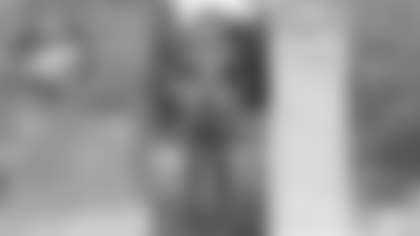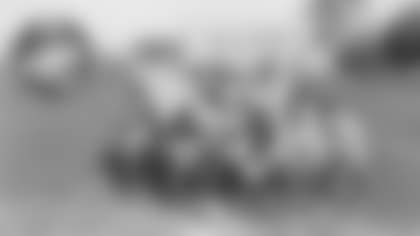Fabian from Schwandorf, Germany
We've heard so much about the Brett Favre retirement saga and so little about Don Hutson's. Could you give us some insight on Hutson's retirements beginning in 1942?
Hutson played from 1935 to 1945 and far surpassed Favre in retirement threats or announcements. Here's the chronological history.
1939 – After contemplating retirement, Hutson signed his contract the evening of Aug. 14 and reported the next day, 10 days into preseason workouts. At the time, he owned a dry cleaning business in Tuscaloosa, Ala., and also was helping football coach Frank Thomas at the University of Alabama.
1942 – In the fall of 1941, Hutson and teammate Buckets Goldenberg opened a bar and bowling alley in Green Bay named the Packer Playdium. As a result, Hutson hinted during the offseason that he might retire, but wound up signing and reporting on time.
1943 – In a radio interview on Jan. 31, Hutson announced his retirement. "Some fellows make a ceremony of announcing their retirement every year," he said. "I meant it last year, but then decided to try one more season. This time I intend to make it stick." On July 20, he insisted he was still committed to retiring. Eighteen days later, Hutson signed his contract, a week ahead of the first practice.
1944 –This time, Hutson announced he was planning to retire in late October 1943, when the Packers were practicing at the Westchester Country Club in Rye, N.Y., for their sixth game of the season against the New York Giants. "I'm playing my last season of football," Hutson declared. "That's positive." Following the Packers' final game of the 1943 season, Hutson repeated that he had just played his last game. Six days later, on Dec. 11, 1943, Hutson signed a contract with the Packers to become a full-time assistant coach. On Sept. 2, 1944, almost two weeks after practice started and 15 days before the season opener, Hutson agreed to play another season.
1945 – On Dec. 17, 1944, in the locker room at the Polo Grounds in New York after the Packers had beaten the Giants for the NFL championship, Hutson declared, "You'll never see me play another game of football in New York. I'm through for good this time. I've got a coaching contract with Curly (Lambeau) and from now on that's what I'm going to do." Two days later, Hutson said he would play in the College All-Star Game in August then retire, something others had done as well because of the importance of that game at that time. On Aug. 30, 1945, after scoring on an 85-yard touchdown in the Packers' victory over the College All-Stars before 92,753 fans at Soldier Field, Hutson repeated his intention to retire. On Sept. 29, 1945, the day before the season opener against the Chicago Bears, Lambeau announced Hutson would suit up and play if needed.
1946 – On Dec. 2, 1945, after the Packers fell to Detroit in the final game of the season, Hutson announced his retirement for the sixth time. This time he stuck to it, although he continued to serve as an assistant coach through 1948.
Cory from Green Bay
I've read that Bob Harlan was the first non-Green Bay native to become president of the Packers. Is that true?
Has it been written? Yes. Is it true? No.
When Harlan was elected president on June 5, 1989, Bob McGinn, then covering the Packers for the Green Bay Press-Gazette, built his story around that statement in the next day's paper. In the second paragraph, he wrote, "The board, in a unanimous vote following no discussion, made Harlan the first non-Green Bay native to lead the franchise in its 71-year history."
Harlan was born in Des Moines, Iowa.
Lee Remmel, then the Packers' executive director of public relations, called Harlan "the first CEO in the organization's annals to come up through the ranks." Remmel further explained the previous eight presidents of the team "had come from the business and professional areas of the community as members of the club's board of directors."
As usual, Remmel got it right.
Bud Lea, who covered the meeting for the Milwaukee Sentinel, wrote in his fourth paragraph, "… this marked the first time the franchise will have someone with NFL experience as president." Pete Faust, covering it for The Milwaukee Journal, wrote in his second graph that Harlan was the first Packers president "with administrative experience in the National Football League."
Both of those statements were true, as well. Harlan had joined the Packers in 1971 as assistant general manager. He was 34 at the time.
One would think the Press-Gazette would have been the least likely of the three papers to get it wrong.
The Packers were founded in its editorial offices on Aug. 11, 1919. What's more, Andrew Turnbull, one of the Press-Gazette's three original owners and the first president of the publicly owned Green Bay Football Corporation, was viewed as the godfather of the newspaper. Turnbull served as president of the Packers from 1923 to 1928 at the same time he was business manager of the Press-Gazette.
Turnbull was born in London, Ontario, Canada, in 1884, grew up in Windsor, Canada, and worked at papers in Detroit, Bay City, Mich., Duluth, Minn., and Saginaw, Mich., before moving to Green Bay in 1915 after becoming part owner of the Green Bay Newspaper Co., publisher of the newly created Press-Gazette.
Dr. William Webber Kelly, third president of the Packers, was born in Kingston, Jamaica, British West Indies in 1875. He was educated in England, went to college in Bruges, Belgium, and attended medical school in Montreal. He came to the United States in 1903.
Emil Fischer, fifth president of the Packers, was born in Plymouth, Wis., in 1887. He moved to Green Bay in 1908, but later ran businesses in Marion, Wis., and Sturgeon Bay, Wis., before settling in Green Bay in the early 1920s.
Russ Bogda, sixth president of the Packers, was born in Burnett, Wis., in 1911, and moved to Green Bay in 1925, subsequently graduating from Green Bay East High School. Burnett is located in Dodge County.
Thus, Harlan was the fifth non-Green Bay native to be president of the Packers.
Mark from Byron, IL
I've heard when the Bears lost the coin flip in 1969 to the Steelers, who selected Terry Bradshaw, the Bears then traded the No. 2 pick to the Packers. Who did we give up and whom did we select?
The Bears and Steelers both finished 1-13 in 1969 and the expectation was either Purdue quarterback and Heisman Trophy runner-up Mike Phipps or Louisiana Tech's Terry Bradshaw would be the No. 1 pick in the draft.
Thus, four days after the NFL season ended, when Phipps and Bradshaw faced each other on Christmas Day in the old North-South All-Star Game in Miami, 80 pro scouts were on hand. Bears head coach Jim Dooley was there along with six other representatives from the Bears.
Phipps led the North to a 31-10 victory, but he and Bradshaw finished with almost identical stats.
On Jan. 9, 1970, NFL commissioner Pete Rozelle held a coin flip in New Orleans to determine the No. 1 pick and the Steelers won. The Bears were now 1-14, wrote Cooper Rollow of the Chicago Tribune. By then, Dooley also had spent the week in Mobile, Ala., personally scouting Bradshaw for the third time.
Two days after the coin flip, Bradshaw completed 17 of 31 passes for 267 yards, uncorked several throws of more than 60 yards and was named MVP of the Senior Bowl as his South team tied the North, 37-37. Dennis Shaw, another highly touted quarterback, threw for 386 yards for the North. Phipps chose to play in the Hula Bowl, where the Bears sent defensive line coach Abe Gibron to do their scouting.
While speculation was rampant that the two QBs would go 1 and 2, it wasn't necessarily a sure thing.
The Bears' George Halas Jr. said before the flip that Bobby Douglass, their second-round pick in 1969, is "our quarterback of the 1970s." And when the Steelers won the flip there was immediate speculation they might trade the choice to Minnesota for quarterback Gary Cuozzo and running back Clint Jones. The Steelers also were high on their second-round selection from the previous draft, Terry Hanratty.
Twelve days later, the Bears traded the No. 2 pick to the Packers for linebacker Lee Roy Caffey, halfback Elijah Pitts and center Bob Hyland. The Bears were elated. "The draft is a luxury thing," said Dooley. "But at this time, we felt we couldn't pass up the opportunity to get proven talent."
Pitts had played sparingly in 1969, but Hyland had been the Packers' No. 1 draft choice two years earlier and Dooley thought Caffey would be the final piece to the Bears having as good a linebacking trio as anyone in the league. Dick Butkus and Doug Buffone were their entrenched starters. Although Hyland had started three games for the Packers in 1969, he hadn't been able to unseat Ken Bowman. "He snapped the ball too hard for Bart Starr," said Dooley, adding that wouldn't be a problem with Hyland snapping to Douglass.
The draft started on Jan. 27 and Bradshaw went No. 1 to the Steelers. The Packers took Notre Dame defensive tackle Mike McCoy with the No. 2 choice. Phipps went third to the Browns.
Pitts didn't play a down for the Bears. He was waived on the final cut before the 1970 season and sold to New Orleans. Caffey and Hyland each played one season in Chicago. A year later, Caffey was beaten out by Ross Brupbacher in training camp and traded to Dallas. A week prior to that deal, Hyland was shipped to the New York Giants.
McCoy was a starter for seven years in Green Bay, but never made a Pro Bowl or received any all-pro mention. Disappointed with his play, the Packers moved him to offensive guard for a two-week trial in 1977 and then traded him to Oakland. The Packers, in turn, got a No. 1 pick in the deal and used it to draft John Anderson.
The Steelers were the only real winners. Of the 26 first-round picks that year, only Bradshaw has been inducted into the Pro Football Hall of Fame.
"Phipps was the guy they were comparing to Bradshaw," Art Rooney Jr., director of player personnel for the Steelers at the time, told me in 1978. "They were running neck-and-neck, and then it was like Secretariat just pulled out in front. When they got to the stretch, it was all Bradshaw. They ran pretty close around the track to the back turn and then Bradshaw just left (Phipps) 20 furlongs behind."
Yet Art Jr. said his dad was still involved with the draft and intrigued by the possibility of trading the choice even though Art Sr. had been fleeced a number of times over the years by swapping prime draft picks. Let's not forget, as of 1969, the Steelers had been in business for 35 years and had never played in a championship game.
"I'll never forget my dad," said Art Jr. "He said maybe you should trade." At that point, Art Sr. contacted Atlanta about a possible swap, but finally came to the realization, according to Art Jr., that, "You can't give up a guy like Terry Bradshaw and expect to win championships."
Tom from Chicago
Charlie Mathys, who played quarterback for the Packers from 1922-26, was a graduate of Green Bay West High School. Wikipedia states that, "At the time (Mathys) was in high school, the Green Bay Packers practiced against local high school teams." This doesn't seem possible. Should I be looking at the Packers' website instead?
Yes.
As for Wikipedia, I've looked at it, but I never use it. The Associated Press Stylebook for newspapers states, "… it should not be used as a primary source for stories." The Chicago Manual of Style, probably used more by authors who do serious research, goes further and states it's "not considered an appropriate source of information."
Mathys graduated from West High in 1915. That meant his senior season of football was 1914. The Packers were founded in 1919. Obviously, Mathys didn't scrimmage against the Packers when he was at West.
But when Mathys was with the Packers, he practiced against Green Bay East High School on Nov. 1, 1923. A week later, the Packers also held a dummy scrimmage either against East or perhaps West. The school wasn't named. Actually, my hunch is that it wasn't unusual for the Packers in their early years to practice against East and maybe West. After all, both schools were state, if not national, high school football powers at the time.
Here’s Mathys’ bio on our website.




